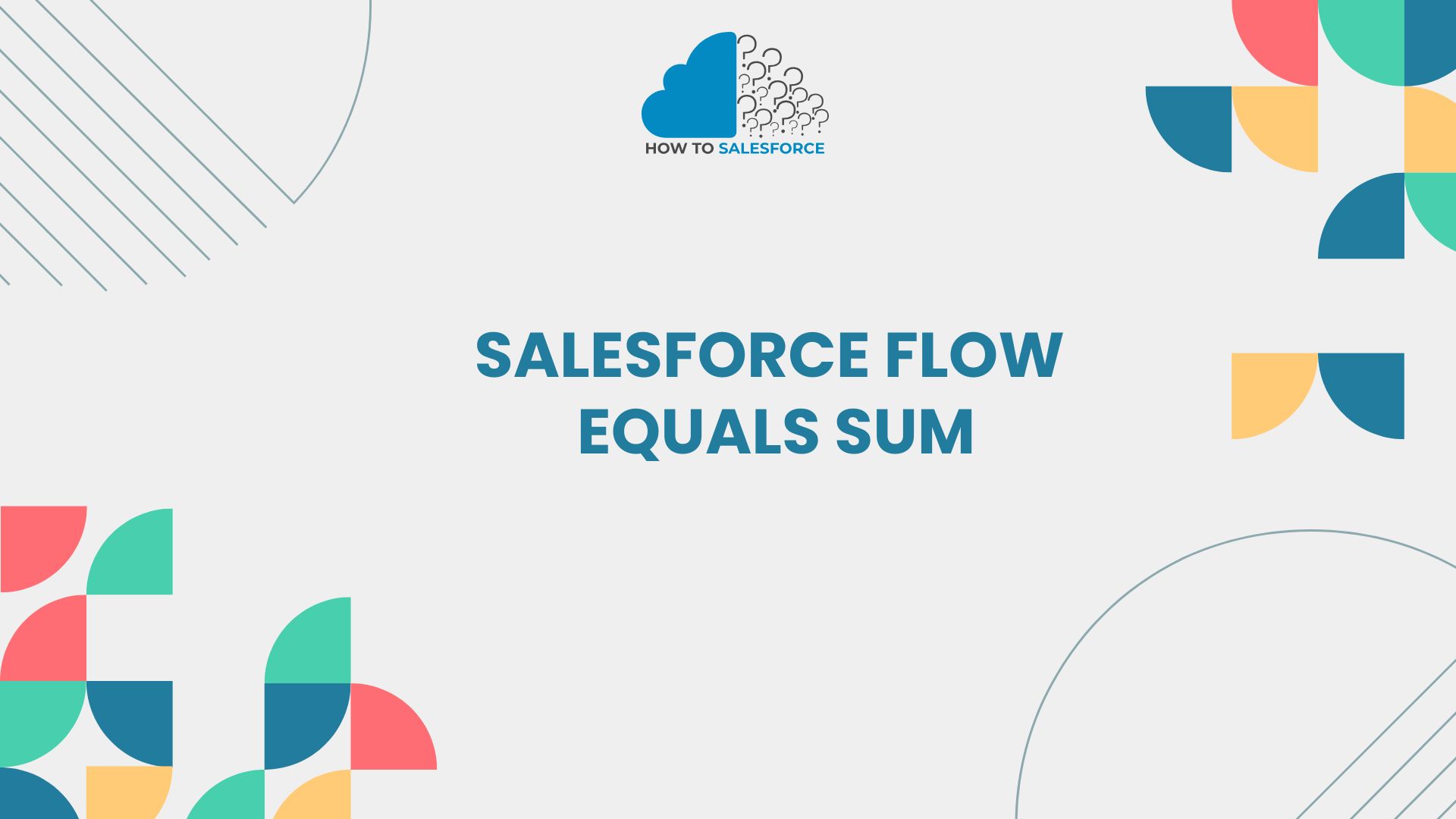Introduction
Salesforce flows provide strong automation capabilities for corporate data management. One crucial application is leveraging the Salesforce flow equals sum capabilities. Thanks to this feature, teams can add values automatically, streamlining data processing and boosting productivity. Here’s how to get the most out of Salesforce Flow.
Hungry for more insights? Check out my other blog post: How to Get File Upload on an Experience Page Salesforce.
What Is Salesforce Flow Equals Sum
Calculations, data updating, and process management are all automated by Salesforce flows. One particular tool in Salesforce flows that makes the process simpler is the equals sum function, which adds values from fields across records. Flows carry out complex calculations or repetitive data entry by establishing criteria for computations.
- Saves time: by automating time-consuming computations.
- Increases Accuracy: Lowers data management errors.
- Improves Productivity: Makes time for important work.
The Salesforce flow equals sum feature helps teams efficiently automate processes.
Benefits of Using Salesforce Flow Equals Sum
There are instant benefits to using Salesforce flow equals sum. It’s a useful tool for the following reasons:
Automate Complicated Figures
The equals sum function automatically sums fields across records when calculations become complex, which lessens workload.
Decreases the Need for Human Data Entry
Data entry by hand takes a lot of time and is prone to errors. By removing this risk, flows maintain consistent and trustworthy data.
Increases Process Speed:
Flows simplify task handling and allow for quicker decision-making by completing computations in a matter of seconds.
Assures Precise Reporting
Accurate reporting is made possible by calculated values using flow equal sum. Sales information, financial records, and performance indicators remain precise.
Setting Up Salesforce Flow Equals Sum in Your Flow
Let’s now examine how to optimize your workflows by configuring Salesforce flow equals sum.
Step 1: Define the Criteria
Establish criteria first so that Salesforce knows what information to add to the total. For instance:
– Apply filters to particular records.
– Define the fields that are used in the computation.
– Establish criteria according to business requirements.
By defining criteria, data overload can be avoided and only the necessary data is calculated.
Step 2: Configure the Equals Sum Feature
Next, set up the flow’s equals sum feature. Here is how:
- Open Salesforce’s Flow Builder.
- Pick the data source and select the Get Records element.
- Calculate across a selection of records using the Equals Sum condition.
You have control over the values that flow computes with these configurations.
Step 3: Add Action Elements to the Flow
Incorporate Action Elements into the process to allow for automated reactions to computed data. For instance:
- Field Update: Adds summed values to fields.
- Record Create Uses computed sums to create records.
- Notification: Based on sum values, alerts are sent.
By automating responses to calculated sums, these actions enable you to take immediate action in response to new information.
Step 4: Test Your Flow
Lastly, make sure the calculations function as intended by testing the flow. This is a checklist:
– Make sure the calculations meet your needs.
– Verify that flows start up immediately.
– Use sample data to check for accuracy.
The Salesforce flow equals sum feature’s functionality is confirmed through testing.
Common Use Cases
Sales Forecasting
You can automate sales forecasts by using Salesforce flow equals sum. You can compare goals with actual performance and add up sales numbers from various accounts.
Inventory Management
The equals sum feature for inventory adds quantities from different warehouses or locations. Accurate stock levels and effective order planning are ensured by this total.
Expense Tracking
Expense tracking flows add up each expense to determine the total cost. With precise spending information, teams can create accurate budgets.
Goal Tracking
Flow equals sum can also be used to add up milestones or goal completions. This speeds up the achievement of corporate goals and allows for the measurement of progress toward performance metrics.
Best Practices
Use these best practices to optimize Salesforce flow, which equates to overall effectiveness.
Plan Your Flow in Advance: Salesforce Flow Equals Sum
Plan the purpose of a flow before you create it. Put calculations, actions, and potential results in writing. Errors are less likely when planning is done well.
Organize Data by Relevance
Relevance-based record filtering guarantees that only pertinent data is computed. Arrange your documents so that the flow equals sum function operates effectively.
Test and Refine Regularly
Test flows using actual data after they have been created. Periodically improve procedures to maintain precise computations and effective workflows.
Optimize Flow Performance
Overloading complex flows can cause them to slow down. To maintain the effectiveness of flows:
– Reduce the number of steps in a single flow.
– Employ suitable filters to limit data.
– Steer clear of pointless computations.
Observing these procedures maintains smooth flows.
Troubleshooting Issues
Even with a meticulous setup, problems may occur. Here’s how to troubleshoot common issues with Salesforce flow equals sum.
Problem 1: Calculations Don’t Match Expected Values
Verify these areas if totals seem off:
- Data Source: Verify that data sources contain accurate records.
- Filters: Verify that filters appropriately match the criteria.
- Field Type: Confirm that fields can be used for calculations involving numbers.
Problem 2: Slow Flow Performance
Try these solutions if your flow becomes sluggish:
– Combine several computations to cut down on steps.
– Make use of simplified conditions.
– Make sure the sources of the data aren’t too big.
Performance problems are avoided with effective configurations.
Problem 3: Incomplete Calculations
Make sure filters are configured to include all pertinent records if some aren’t included in sums.
Advanced Tips
Use Nested Flows for Complex Calculations
For more complex computations, the nest flows inside one another. You can manage numerous calculations across related records with nested flows, which improves automation overall.
Integrate with External Data: Salesforce Flow Equals Sum
Richer insights are obtained by integrating Salesforce with external data sources for companies that use multiple platforms. For instance:
- ERP Systems: Compile financial information from various platforms.
- Marketing Software: Incorporate campaign or ad values.
Apply Conditional Logic in Flows
You can set various actions depending on sum values by utilizing conditional logic inflows. For instance:
– If the total expenses surpass the budget, let a manager know.
– Create more records in response to certain thresholds.
Conditional logic allows for customized workflows that rely on calculations.
Improving Efficiency
Workflow efficiency is increased by using Salesforce flow equals sum. Instantaneous calculations allow teams to make decisions more quickly. Automatic sales forecasting, for instance, reduces the amount of time needed for manual calculations.
Furthermore, flow equals sum, which lowers data errors and encourages uniform values among teams. Your team can concentrate on important tasks as repetitive tasks become more manageable.
Salesforce Flow Equals Sum
Examine the following example to see Salesforce flow equals sum in action:
- Business Case: A business wishes to monitor monthly sales by geographic area.
- Solution: The sales team keeps track of every record by location using equals sum.
- Result: The team swiftly assesses each region’s performance and fixes areas that require attention thanks to automated computations.
Conclusion
Flow Equals Sum in Salesforce automates necessary data calculations. When configured correctly, it makes teams more efficient, encourages accuracy, and eliminates the need for manual data entry. Salesforce flow equals sum, which can help you increase productivity in your Salesforce environment by streamlining calculations.


